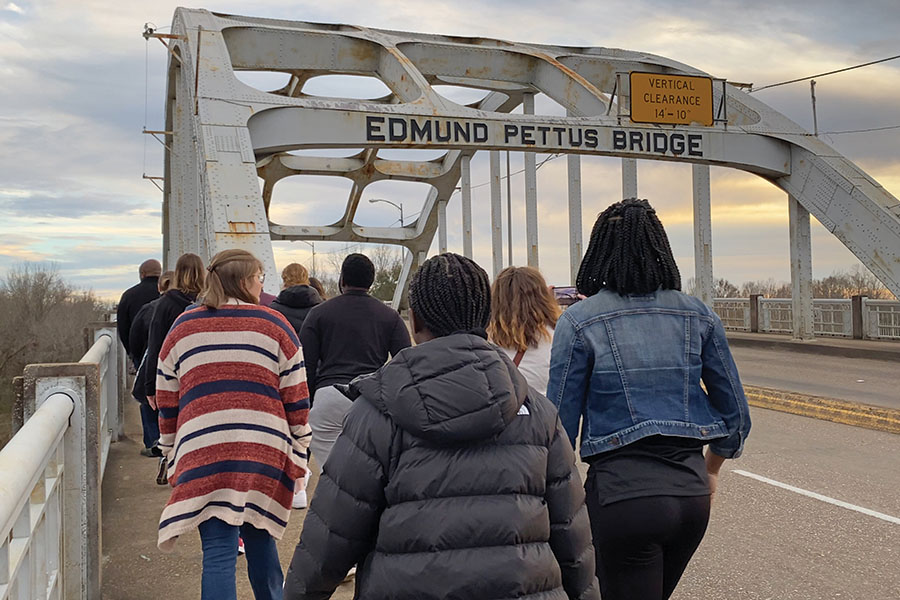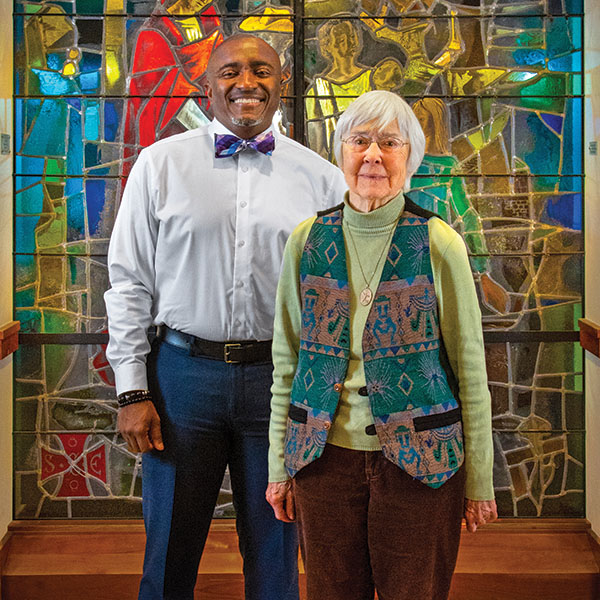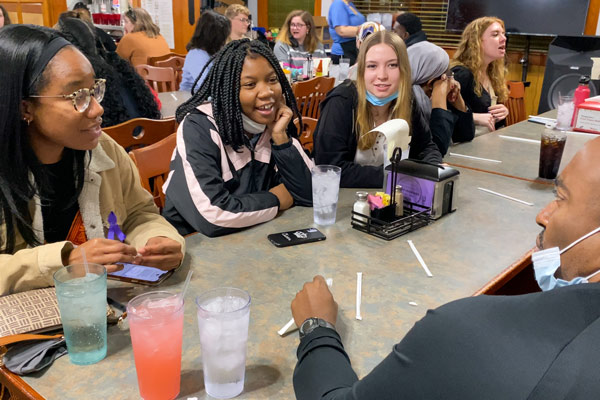Feature
Cultivating Belonging: What’s past is prologue
As diversity, equity, and inclusion work evolves, touchstones abound in the Nazareth legacy.
by Erich Van Dussen

In January, more than two dozen Nazareth students, faculty, and staff embarked on an eight-day exploration of historical sites in the Deep South. The trip included a stop at the Edmund Pettus Bridge in Selma, Alabama, where civil rights marchers in March 1965 were attacked on what became known as Bloody Sunday.
Wayne Hilson, Ph.D., Nazareth’s vice president for Culture, Community, and Belonging, recalled that walking across the bridge with the students was “a powerful moment”— as was a chance comment offered by a local resident shortly thereafter. “We asked him what it was like to live in what, in many ways, is the epicenter of the Civil Rights movement,” Hilson said. “And he said to us, ‘I think people are still standing on the bridge.’
“I think what he meant by that is that we’re still figuring out how our history can inform the new issues and problems of today, while continuing to remain focused on our future,” Hilson noted.
Reconciling where we’ve been with where we’re going is a natural part of any purposeful journey to build and maintain a vibrant community. At Nazareth, Hilson observed, the most recent achievements in that ongoing journey reflect exciting steps forward — while still being fully of a piece with the institution’s history.
“The work we’re doing today owes so much to what has been fundamental about Naz all along,” he said.
Expanding the focus
One of the most obvious examples of Nazareth’s evolution in this area can be found in the renamed division of Culture, Community, and Belonging (CC&B), a constellation of words that didn’t exist in that form just a few years ago.
“It speaks to a more expansive lens through which we think about diversity, equity, inclusion, and belonging work,” Hilson said, with the specific addition of culture suggesting that “all of us have a role to play … making sure that no matter where a student lands on campus, there’s fertile ground for them to bloom.”
In keeping with this holistic view, CC&B is home to five areas of focus that provide distinct but related resources and supports and align with Nazareth’s Strategic Plan for Diversity and Inclusion. Those offices collaborate, encourage, and coordinate efforts within and outside of the college community — and lift up the impact of everyone’s work.
Notable recent Nazareth achievements have included the development of a leadership-oriented scholarship program offered in partnership with the Corella and Bertram F. Bonner Foundation. Each year, the program accepts 15 students committed to community engagement and service learning, and provides financial support as well as opportunities to grow as changemakers and community leaders. Nazareth’s Bonner Leader program is the only one in the Rochester region.
In 2022, Nazareth was recognized as a “Most Engaged Campus” as part of the national ALL IN Campus Democracy Challenge. This honor emanated from the work of NazVotes, a campus partnership dedicated to promoting civic participation through voter registration and voting.
Also last year, the Arc of Monroe presented Nazareth with its Cornerstone Award for the LifePrep@Naz program, which provides innovative engagements for students with intellectual and developmental disabilities. Since its launch a decade ago, LifePrep@Naz has helped dozens of participating students enjoy more enriching college experiences — fostering greater inclusivity by opening academic and social doors to the young adults — while also giving their Nazareth peers a broader lens through which to view the community around them.
A recent $2.6 million U.S. Department of Education grant, secured by Nazareth academic departments, funds scholarships for social work or art therapy graduate students who want to work as mental health professionals in high-needs school districts. Nazareth is one of only 67 institutions nationally to receive this funding — one of the largest federal grants ever awarded to the college.
Individually and collectively, Hilson said, these examples and many more are evidence of how the work on culture, community, and belonging work undergirds and enhances the collegiate experience of every Nazareth student.
“It’s part of classroom learning, but it also exists outside of it,” he said. “It helps our students prepare to have challenging conversations, to dialogue across difference, to gain some understanding of other worldviews, even as they’re bringing their own histories, values, and perspectives in tow.”
Fidelity to a founding vision
The January 2023 trip to Selma was far from the first connection between Nazareth and that historic location. In 1944, 20 years after founding Nazareth College, the Sisters of St. Joseph of Rochester opened the Good Samaritan Hospital in Selma, specifically for the purpose of providing health care to underserved populations in that highly segregated city and surrounding rural areas.
Her education and training as a nurse brought Barbara Lum ’58, SSJ, to Selma after graduation, and she was among the Good Samaritan workers who cared for the Bloody Sunday protestors in the aftermath of that infamous 1965 attack.
Today, Lum is back in Rochester following years of work as a nurse, an educator, and a dedicated community servant. During a recent conversation at the SSJ Motherhouse adjacent to the college, while listening to Hilson describe the ongoing evolution of Nazareth’s work on culture, community, and belonging, she acknowledged feeling a sense of pride — and familiarity.
“I'm super impressed — very, very impressed,” Lum said. “I realize we're in a different world than the 1950s when I was a student, but the Sisters of St. Joseph always had the idea of reaching out and serving where we are, and learning.
“They had a very broad view,” she added. “The idea of belonging [and] being part of the community, reaching out, was very much a part of the founding sisters’ vision.”
Although the specifics differed in many ways between a Nazareth education of her time and the experiences of students today, she said, the essential interweaving of a community focus and service-based learning into the formal curriculum has remained clear and constant.
Then, as now, “we all developed a greater awareness of the differences and the similarities of the people that we were working with, and loved, and admired, and wanted to educate,” Lum recalled. “But they also educated us. Big time.”
‘A certain courage’
“May I ask a question?” Hilson said to Lum during their conversation at the Motherhouse. “As you think about the congregation through the years, particularly what the Sisters have done in the Deep South, where has courage fit within the work?”
“Well,” Lum responded after a pause, “I think courage always has to be there. It's a gift. We had a very steady prayer life, very steady community life. So that comes out of that kind of faith and faithfulness.”
Hilson noted parallels with Nazareth’s CC&B progress today. “When we're talking about [the modern] work, particularly if you're exposing people to some things … or differences that they haven't had to think about, it takes a certain level of courage to kind of question self, to think about what you don't know but you thought you knew about the lived experiences of others. And so I always think about the courage to take that first step to act.”
Looking ahead
What does success look like for these CC&B efforts? How can Nazareth know if it’s working? Student and alumni check-ins and other quantitative metrics will always be important, Hilson said, but qualitative measures are equally critical.
“We’re really focused on storytelling” as one example, he noted. “How do we bring to bear the stories and experiences of our students [and] our faculty and staff? And then just always checking in with the foundations of what we do. When it's all said and done, to what extent are you staying true to the foundational aspects of the institution? That's probably the most important metric we have.”
Examples of outreach are everywhere. In an email sent to the college community at the start of the fall 2023 semester, Hilson welcomed the incoming classes, expressed excitement for all that’s been achieved to date with regard to culture, community, and belonging at Nazareth, and encouraged the energetic pursuit of continued progress.
“Our founders provided the blueprint,” he wrote. “Let us continue this journey together in the spirit of accountability, grace, and action. Let us continue to build!”
Erich Van Dussen is a freelance writer in Rochester, New York.

Wayne Hilson, vice president for Culture, Community, and Belonging, poses with Barbara Lum ’58, SSJ, at the SSJ Motherhouse.

Conversation and connection
Everyone at Nazareth plays a role in creating fertile ground on which students can bloom.
(Photo of students and staff on Nazareth's Civil Rights Journey 2023)